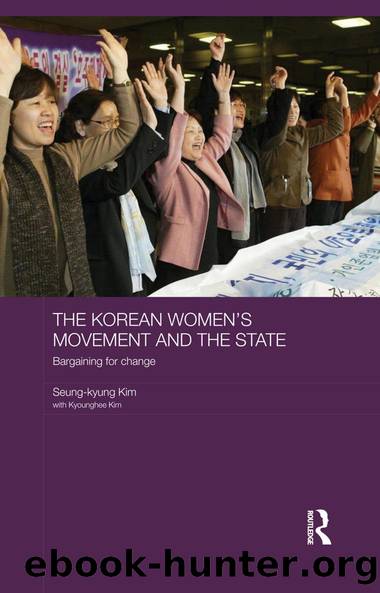The Korean Women's Movement and the State by Seung-kyung Kim Kyounghee Kim

Author:Seung-kyung Kim, Kyounghee Kim [Seung-kyung Kim, Kyounghee Kim]
Language: eng
Format: epub
ISBN: 9781138204522
Google: P0jEjwEACAAJ
Barnesnoble:
Publisher: Taylor & Francis
Published: 2016-06-30T01:01:05+00:00
The developmental state, international pressure, and coalition of womenâs groups
The Republic of Koreaâs legal system was severely disrupted in 1961 when Park Chung Hee staged a military coup dâétat and replaced the existing government with the Supreme Council for National Reconstruction. The council suspended the constitution, dissolved the National Assembly, and prohibited all political activities. It was under the Supreme Council that the first revision of the family law was carried out, on December 31, 1962. Parkâs dictatorial regime sought to transform and modernize Korea, so it was willing to accept modifications to tradition for the sake of efficiency. As a result, the 1962 revision sought to establish each nuclear family as an independent unit (Yang 2008: 80).
Parkâs coup introduced three decades of military rule, during which time economic development became the overriding policy objective. Parkâs policies included building up the countryâs manufacturing base, revitalizing the rural areas, and promoting family planning. During his presidency Korea transformed from one of the poorest countries in the world to a country with a bustling economy.
During the Park regime, political activity was highly restricted, but the Korea Legal Aid Center for Family Relations (1956) and the Korean National Council of Women (KNCW, 1959), organizations that had been established before the coup, continued to advocate for revision of the family law. These organizations were headed by women who came from privileged family backgrounds and who had been able to receive higher education, and therefore represented a rather narrow cross-section of society. Even though these women worked hard to bring womenâs issues to the public, the movement at this time was limited to middle-class, professional women, rather than being a broad, grassroots movement.
One issue that brought about a significant convergence of interests between the government and womenâs organizations was family planning policy. In 1960, the average family had six children, and the government, realizing that limiting population growth was essential to their plans for the economy, instituted birth control as a national policy. The Planned Parenthood Federation of Korea was established in 1961. Koreans at this time, however, still favored large families and were not ready to accept family planning unless they had at least one son. Faced with strong resistance, especially from rural families, the Ministry of Health and Welfare began working with womenâs groups. Despite their different agendas, their cooperation suggests they shared an interest in modernizing gender relations. In fact, the Ministry of Health and Welfare even recommended reforming family law in order to âgrant more rights to daughtersâ (Shin 2006: 103).
During the 1970s, as Park Chung Heeâs regime became more rigid and authoritarian, it also reverted to an emphasis on Korean âtraditional valuesâ to buttress its position. The two core values that the government stressed were loyalty to the nation, châung, and filial piety to the parents, hyo. By linking itself to traditional Confucian values, the government again placed the family at the core of national identity. Resistance movements that formed during this time were harshly suppressed, but, in countering the
Download
This site does not store any files on its server. We only index and link to content provided by other sites. Please contact the content providers to delete copyright contents if any and email us, we'll remove relevant links or contents immediately.
On the Front Line with the Women Who Fight Back by Stacey Dooley(4800)
The Rules Do Not Apply by Ariel Levy(4795)
The Lonely City by Olivia Laing(4714)
Bluets by Maggie Nelson(4438)
The Confidence Code by Katty Kay(4166)
Three Women by Lisa Taddeo(3329)
Not a Diet Book by James Smith(3302)
Inferior by Angela Saini(3214)
Confessions of a Video Vixen by Karrine Steffans(3212)
A Woman Makes a Plan by Maye Musk(3179)
Pledged by Alexandra Robbins(3106)
Wild Words from Wild Women by Stephens Autumn(3047)
Nice Girls Don't Get the Corner Office by Lois P. Frankel(2975)
Brave by Rose McGowan(2766)
Women & Power by Mary Beard(2693)
Why I Am Not a Feminist by Jessa Crispin(2670)
The Girl in the Spider's Web: A Lisbeth Salander novel, continuing Stieg Larsson's Millennium Series by Lagercrantz David(2649)
The Clitoral Truth: The Secret World at Your Fingertips by Rebecca Chalker(2635)
Women on Top by Nancy Friday(2494)
